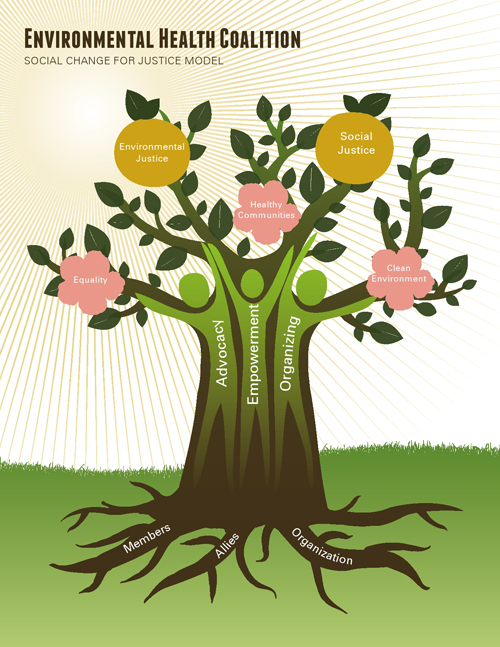 Social Change for Justice Model (SCFJ) is a framework integrating EHC's ideology and strategies to increase our ability to achieve social and environmental justice goals. The model incorporates all aspects of the EHC structure and method of work recognizing the critical importance and integration of our three core strategies: community organizing, policy advocacy and leader empowerment.
Social Change for Justice Model (SCFJ) is a framework integrating EHC's ideology and strategies to increase our ability to achieve social and environmental justice goals. The model incorporates all aspects of the EHC structure and method of work recognizing the critical importance and integration of our three core strategies: community organizing, policy advocacy and leader empowerment.
After over 30 years, we know a lot about what works and what doesn't. We know that we have a much better chance of accomplishing our goals by using a strategic, disciplined and deliberate approach. The model enhances the ability of EHC staff and community leaders to work effectively by increasing the consciousness with which the work is conducted and by providing clear guidance for how to do it.
The EHC Social Change for Justice Model guidance includes:
- The EHC ideology provides the foundation for our work -- mission, goals, and theory of social change. These must be visible and incorporated into every effort
- A method of analysis, planning, action, and evaluation which defines the steps and stages used for every effort
- Leadership development to empower community members to achieve self-determination for themselves, their families and their communities
Core Strategies – Community Organizing, Policy Advocacy and Leadership Development
Organizing, advocacy and leader empowerment are fundamental to the work of many social justice organizations and change models. EHC has found that recognizing the unique nature and requirements of each strategy and intentionally integrating them results in stronger and more effective campaign outcomes.
Community Organizing
EHC defines community organizing as "a values-based strategy that educates and empowers people to take action to win real improvements in their lives for the benefit of their communities and the common good."
The three major base-building tactics of organizing are:
Building -- Identifying and involving individuals who believe in EHC's Mission and Goals and who want to work to achieve specific changes in their communities
Mobilizing -- Activating members to take specific actions in order to demonstrate broad and deep support for EHC efforts
Maintaining -- Increasing participation, deepening commitment and expanding political consciousness of EHC members
Policy Advocacy
EHC defines policy advocacy as "a values-based strategy that represents, champions and defends the public's interest and affected communities."
EHC advocacy efforts follow a Problem-Solution-Action flow described as:
Problem -- Conducting issue research and power analysis to understand the conditions and identify the injustice
Solution – Determining the best and most winnable solution to reach the desired goal
Action – Implementing a strategic plan with clear goals, objectives, tactics and targets
Leadership Development
Since EHC's work supports our community base, leadership development is critical to achieving success. As EHC members become more deeply involved, they are invited to participate in EHC's signature leadership training, SALTA (Salud Ambiental Líderes Tomando Acción - Environmental Health, Leaders Taking Action). SALTA provides skills training on organizing, advocacy, power, and communications and educates about environmental health and justice issues.
Leaders who have completed SALTA are invited to become members of one of EHC's Community Action Teams (CAT). These teams are established in every EHC target community. CAT members are EHC leaders who guide the development and implementation of strategy for each campaign, program and effort. Some CAT members then join the EHC board of directors to guide the organization's vision and direction. Approximately 50% of board members are CAT members.

